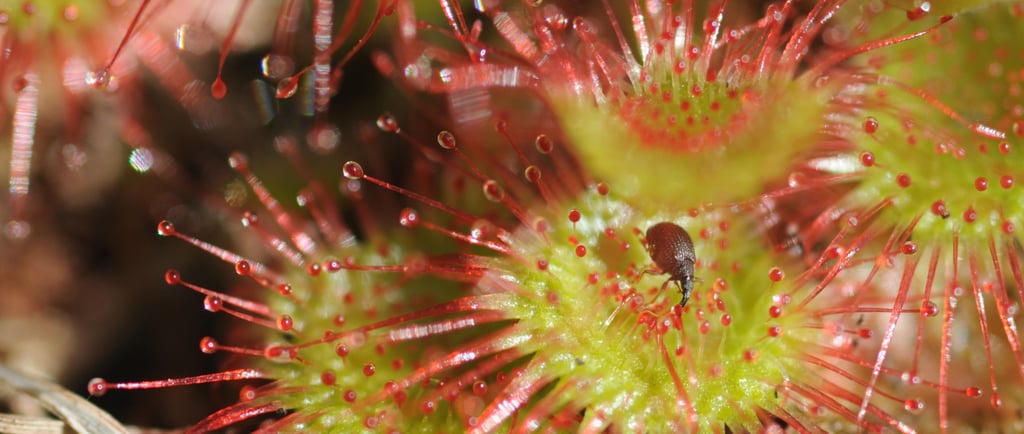Meet the mobsters of the plant kingdom
Carnivorous plants are a backwards trip around the circle of life.
PLANTS
Sherry McPhail
7/1/20242 min read


A doomed bug tries to escape a sticky sundew leaf. Photo by Sherry McPhail.
It’s true: our planet is just weird enough that some plants eat animals.
When you think of carnivorous plants, what’s the first one that comes to your mind? Probably the venus flytrap, right? I always pictured this toothy number growing in a lush jungle, snapping up giant exotic insects in its trigger trap.
But in fact this famous meat-eating flora doesn’t grow in a jungle: it’s native to only two American states: North and South Carolina. (Okay, so maybe it's a little tropical there.)
The thing is, carnivorous plants are more widespread than we think. There’s probably one in a swamp near you, munching right now on a sad bug or unfortunate mouse. Mouse? Yup. Mammals are sometimes the unwilling victims (or unwitting collaborators—more on that later) of these flesh-seeking sprouters.
How do they do it? Herbaceous carnivores have all kinds of strategies for getting food into their hungry maws. But first: why are their maws so hungry? Why is photosynthesis (eating air cooked in sunlight, a pretty cool trick on its own) not enough?
In fact most plants, to supplement their light snacking (haha), need to get nitrogen and phosphorus from soil. But carnivorous greenery lives in watery bogs and high in trees, where these elements are rarely on the menu. So they evolved tricks that spare them from getting their roots dirty.
Who knows how that came to be? Maybe a bug drowned in a water-filled leaf whorl, and the plant got some ideas. What we do know is that carnivory is such a good strategy, it evolved at least nine separate times.
Now the world has over 600 known species, in groups so diverse plant-wise that the only thing they really share is their non-vegetarian ways.
How they lure and trap prey is a bait-and-switch story worthy of any hard-boiled thriller: handsome devils, sophisticated cocktails, lightning-fast reflexes and hidden trap doors. Every plot features an ingeniously evolved leaf form to ensnare victims, and a hidden warehouse full of chemicals (enzymes or bacteria) to absorb their life force.
Ready to meet nature’s most patient and sophisticated hunters? Here they are:
The Pitfalls. In this most common kind of trap, the leaf is really a pool for someone’s last swim. Even frogs and mice are not immune to the hazards of a pitcher plant.
The Flypapers. Some shiny, colourful, sticky goo sitting on a leaf (butterworts) or on hairy glands around a leaf (sundews) makes prey go “Ooh, candy!” In 15 minutes it’s curtains.
The Snap Traps. Athletes like venus flytraps slam their leaves shut around hapless bugs, then slowly proceed with their grisly task.
The Bladders: Tiny water creatures trigger open the door of an air-filled bladder and are instantly vacuumed up with the intake of water. Bladderworts are so damn clever.
The Lobster Pots. Just like the classic crustacean trap, corkscrew plants entice creatures into a lair of delights. Dinner over, downward-pointed hairs prevent escape, and no one can hear them scream.
The Scat-Seekers. “Crapivorous” plants don’t bother doing the hard work of digesting bugs. They just partner with poopers to get some nutrient-rich number two in exchange for favours like a nice dry nest or a nectar buffet. Not real mobsters.
So next time you hit the woods, keep an eye out for your local members of this leafy mafia, but don’t turn your back too long.
